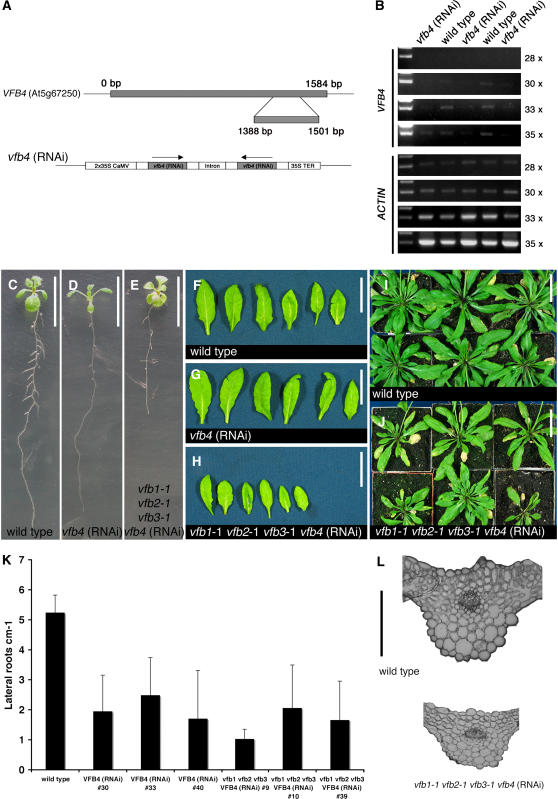Figure 5.
RNAi Suppression of VFB4 Reveals a Role for the VFB Gene Family in Development.
(A) Schematic representation of the VFB4 gene (top panel) and the vfb4 (RNAi) construct (bottom panel) that was selected for suppression of VFB4 expression. Magnified is the 114-bp region between base pair 1388 and base pair 1501 of the VFB4 open reading frame, which shows the highest sequence divergence between all four VFB family members.
(B) RT-PCR (28, 30, 33, and 35 cycles) of three vfb4 (RNAi) lines and two wild-type controls indicates that VFB4 gene expression is reduced in selected vfb4 (RNAi) lines.
(C) to (E) A comparative analysis of 10-d-old light-grown seedlings reveals differences in root growth and lateral root formation between the wild type (C), the wild type transformed with the vfb4 (RNAi) construct (D), and vfb1-1 vfb2-1 vfb3-1 mutants containing vfb4 (RNAi) (E). Bars = 5 mm.
(F) to (J) vfb4 RNAi suppression in the vfb1-1 vfb2-1 vfb3-1 triple mutant ([H] and [J]) but not in the wild type ([G] and [I]) causes growth delay as indicated by the plants' reduced rosette size. Shown are representative leaves ([F] to [H]) and rosettes ([I] and [J]) of 3-week-old plants. Bars = 5 mm in (F) to (H) and 2.5 cm in (I) and (J).
(L) Average and sd of lateral roots formed per centimeter in 10-d-old Arabidopsis seedlings. n ≥ 20.
(M) A cross section from rosette leaves indicates that growth differences in the vfb1-1 vfb2-1 vfb3-1 vfb4 (RNAi) mutants are due to reduced cell size and not due to reduced cell number. Bar = 3 mm.

